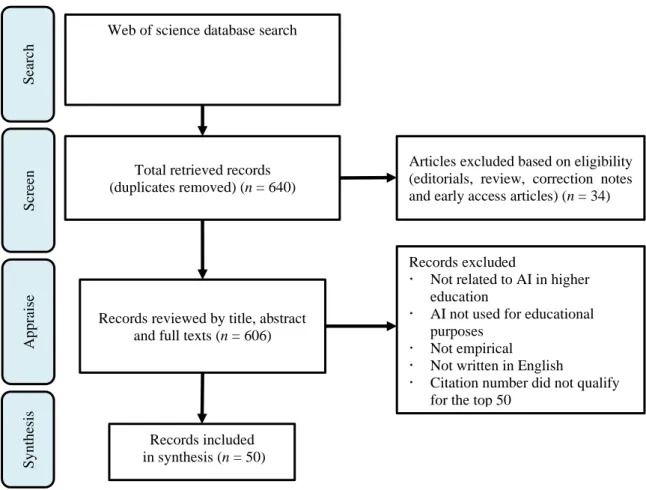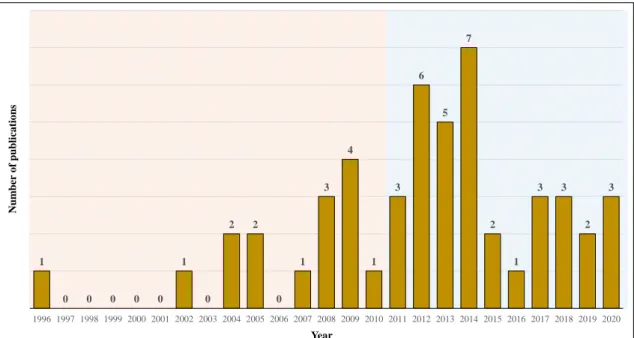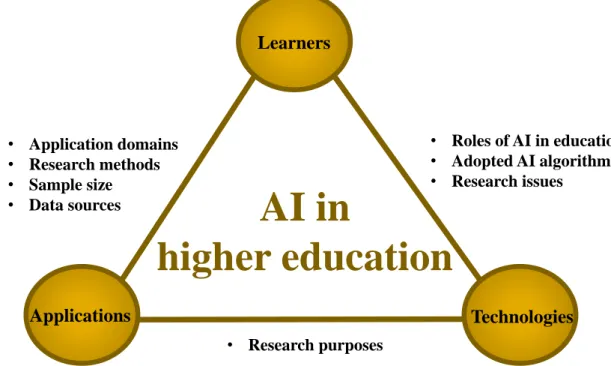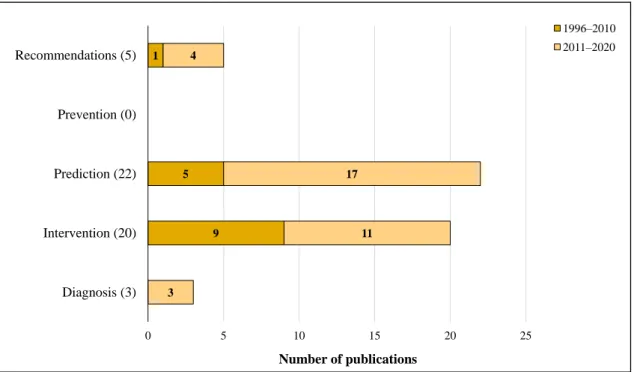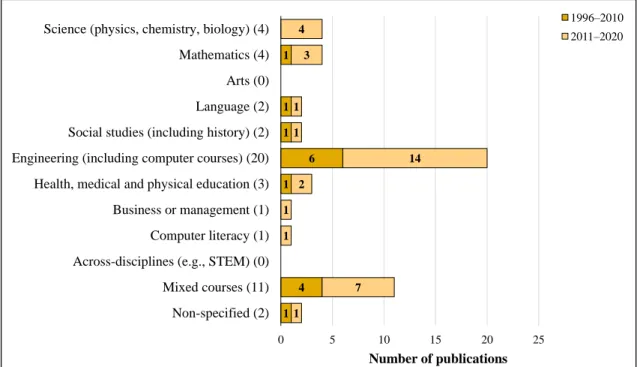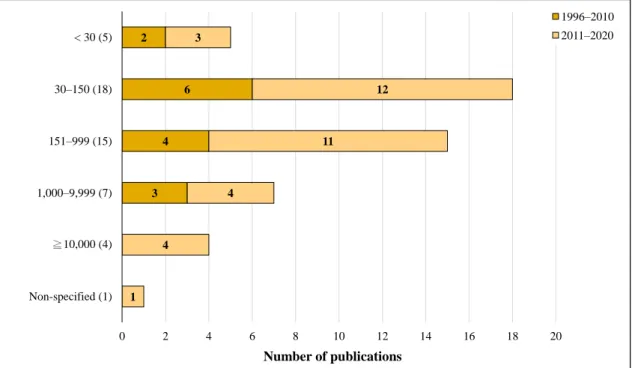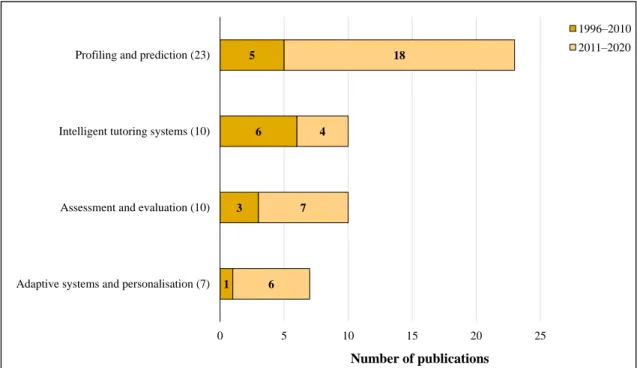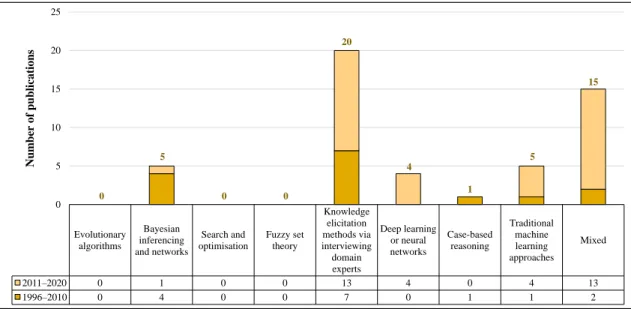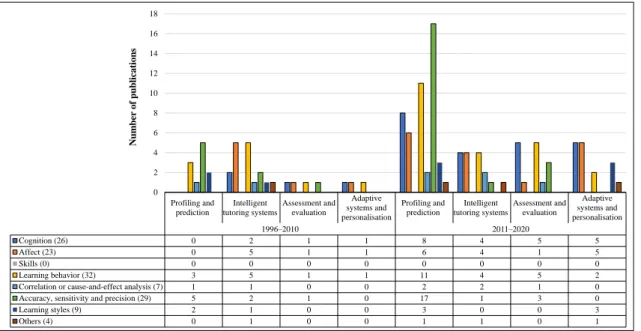Roles and research trends of artificial intelligence in higher education: A systematic review of the top 50 most-cited articles
Hui-Chun Chu
Soochow University, Taiwan Gwo-Haur Hwang
National Yunlin University of Science and Technology, Taiwan Yun-Fang Tu
Fu Jen Catholic University, Taiwan Kai-Hsiang Yang
National Taipei University of Education, Taiwan
Artificial intelligence (AI) in higher education has proven to be a useful learning technology;
it can help learners achieve positive learning outcomes in the learning environment and can also enable teachers to better understand learners’ learning status and further improve their teaching strategies. This study reviewed the top 50 AI in higher education studies in the Web of Science database from the perspective of highly cited papers and based on a technology- based learning model. The results show that predictions of learners’ learning status (including dropout and retention, student models, and academic achievement) are most frequently discussed in the AI in higher education studies; AI technology is most commonly applied in engineering (including computer courses); AI technologies most often play the role of profiling and prediction in higher education, followed by intelligent tutoring systems and assessment and evaluation. In terms of research issues, the most frequently discussed issues are learning behaviour, accuracy, sensitivity and precision, cognition and affect. Learners’
higher order thinking skills, collaboration or communication, self-efficacy or confidence and skills are less frequently discussed in AI in higher education studies. Accordingly, we propose potential research issues and practitioner notes for AI in higher education as a reference for researchers, educators and decision-makers.
Implications for practice or policy:
• Higher education practitioners and researchers need to be aware of the latest developments in the research and practice of AI in higher education.
• Teachers need to understand the role they can play in teaching and learning practices through AI technology and how to use it to assist learners.
• It is important for administrators of educational institutions to understand the challenges teachers face in their teaching practices with AI technology and to develop measures to support them.
Keywords: artificial intelligence (AI), higher education, profiling and prediction, intelligent tutoring systems, assessment and evaluation, adaptive systems and personalisation
Introduction
In recent years, with the advancement of educational technologies, the application of artificial intelligence (AI) in the field of education has attracted great interest from the public, governments and academia (Popenici & Kerr, 2017). In particular, higher education is deeply influenced by the development of information and communication technologies (Alajmi et al., 2020; Bates et al., 2020; X. Chen et al., 2021).
AI technology has human-like abilities such as learning, adapting, self-correcting and using data analysis to accomplish complex tasks (Hwang, 2003; Hwang & Fu, 2020). In the field of education, researchers have explored the application of AI technologies to specific research areas, including e-learning (Tang et al., 2021), engineering education (Shukla et al., 2019), language education (Liang et al., 2021), mathematics
of the use of AI technologies in education, there are three important considerations: the shift of AI technologies from an isolated area of research and development to a consideration of their impact on teaching and learning (i.e., pedagogy); the need for smarter AI in education technology applications that incorporate collaboration between researchers, developers, and educators (i.e., technology); and the co- design of new learning tools or systems with teachers, students, and parents (i.e., system change) (Luckin et al., 2016). In addition, Popenici and Kerr explored the impact of AI on teaching and learning in higher education and pointed out the close relationship between higher education and new technologies and the computing capacities of new intelligent machines.
From the perspective of article information (year of publication, journal name, countries of authorship, discipline of first author), study design and execution (empirical or descriptive, educational settings) and how AI was used (applications in the student life cycle, specific applications and methods), Zawacki- Richter et al. (2019) reviewed the research on AI in higher education from 2007 to 2018. They pointed out that AI technologies can assist in profiling and prediction in higher education (including admissions decisions and course scheduling; dropout and retention; student models and academic achievement), but also as intelligent tutoring systems (ITS), providing diagnostics and adaptive systems and recommending personalised content. In terms of profiling and prediction, AI technologies can assist with the prediction of learner performance (e.g., high dropout rates, low homework completion rates and poor learning outcomes), that is, early detection of at-risk learners and the adoption of preventive measures that could improve their success rates (Luan & Tsai, 2021; Lykourentzou et al., 2009; Wu et al., 2020). Considering ITS, AI technologies can provide guidance to learners during the learning process and organise useful information about learners' learning abilities and progress, further providing teachers with suggestions on how to adapt teaching methods to the learners’ status (Mohamed & Lamia, 2018; Moundridou & Virvou, 2002;
Schiaffino et al., 2008). Regarding assessment and evaluation, AI technologies can analyse learners’
learning states and behaviours, as well as diagnose their individual learning states and provide immediate guidance and feedback, for example, automatic essay scoring (X. Chen, Xie et al., 2020; McNamara et al., 2015). As for adaptive systems and personalisation, AI technologies can solve the traditional one-size-fits- all approach to education and provide learners with personalised and adapted learning experiences and learning styles to enhance their learning effectiveness (Latham et al., 2014; Li et al., 2021; C. F. Lin et al., 2013; Xie et al., 2019).
Therefore, the application of AI technologies for building personalised, adaptive and participatory learning environments and for providing teachers with relevant information about learners’ learning characteristics and status to help teachers intervene and assist learners in a timely manner has become an important issue in higher education research (Bedenlier et al., 2020; Zawacki-Richter et al., 2019). In addition, literature reviews are an important way for exploring trends in higher education research; according to X. Chen, Xie et al. (2020) and Hwang and Tsai (2011), researchers can communicate about educational practices through publishing in scientific journals, allowing them to quickly grasp research-related topics and trends. There are a few examples of educational technology-related literature reviews that have successfully adopted bibliometric analysis to analyse the abstracts and keywords of articles to discover research themes and their trends over a period of time (e.g., X. Chen et al., 2021; X. Chen, Xie et al., 2020; X. Chen, Zou et al., 2020).
However, there are some research dimensions that are not available through bibliographic analysis; thus, some researchers have conducted systemic reviews of the research issues and focused on the application of AI technologies in various fields (e.g., Hwang & Tu, 2021; Tang et al., 2021; Zawacki-Richter et al., 2019).
Researchers have also pointed out that highly cited papers can represent recent changes in specific research and can reflect recent issues or research trends of interest to researchers (Barbera et al., 2020; Cheng et al., 2020; Lai, 2020). In addition, literature reviews have analysed the top 50 or top 100 most-cited publications in various fields such as mobile learning (Lai, 2020), flipped learning (Cheng et al., 2020), nursing student education (Chang et al., 2020), economic development (Asatullaeva et al., 2021) and the energy-growth nexus (Ahmad et al., 2020). However, to date, no literature review has examined the characteristics and impact of AI in higher education publications from the perspective of highly cited papers. The present study was based on Chang et al. (2020), Hwang et al. (2021) and Hwang and Tu (2021). In terms of research purposes, application domains, research methods, sample sizes, data sources, roles of AI in education, adopted AI algorithms and research issues, and from the perspective of significant productive authors, we
(1) What were the primary research purposes of AI in higher education studies?
(2) What were the application domains, research methods, sample sizes and data sources of AI in higher education studies?
(3) What roles of AI, adopted AI algorithms and research issues were investigated in AI in higher education studies?
(4) Who are the top 10 most productive authors of the top-50 cited articles?
Research methods
To perform this systematic review, the principles and guidelines of PRISMA provided by Moher et al.
(2009) were adopted in this study.
Process of data searching and collection
The WoS database was selected for the search because of its reliability and authority. Based on Hooshyar et al. (2020) and Zawacki-Richter et al. (2019), we conducted the search process in the WoS database and reviewed the bibliographies of all relevant articles. Finally, those articles that investigated AI applications in higher education were selected. To optimise the relevance, this study used various keyword groups to search for AI in higher education articles in the “education/educational research category” in the WoS database: artificial intelligence (“artificial intelligence” or “machine intelligence” or “intelligent support”
or “intelligent virtual reality” or “chat bot*” or “machine learning” or “automated tutor*” or “personal tutor*” or “intelligent agent*” or “expert system*” or “neural network*” or “natural language processing”
or “chatbot*” or “intelligent system” or “intelligent tutor*”) AND higher education (“higher education” or
“student” or “university” or “postgrad*” or “undergrad*” or “sophomore” or “college” or “course” or
“freshman” or “tertiary” or “post-secondary education” or “pupil”). A total of 640 Social Sciences Citation Index articles were obtained on August 31, 2021. To be included in this systematic review, each study had to meet the criteria indicated in Table 1.
Table 1
Inclusion and exclusion criteria
Inclusion Exclusion
Must involve AI technologies in formal or informal learning with clear descriptions of practical applications.
Editorials, review, correction notes and early access articles
Not related to AI in higher education AI not used for educational purposes Not written in English
Not in the top 50 cited articles
Figure 1 presents the article selection process. First, editorials, reviews, correction notes and early access articles were excluded, leaving 606 articles for review. Following that, a manual review process was conducted to examine the paper title, abstract, and full texts of each article, using inclusion and exclusion criteria. Next, the full text of the remaining articles was reviewed to determine whether they met the eligibility criteria for the final sample. Finally, a total of 50 articles were included.
Figure 1. WoS database searching steps Data distribution
Figure 2 presents the distribution of the top 50 most-cited AI in higher education articles. The publication years of these articles range from 1996 to 2020, which indicates that the frequently cited AI in higher education studies date back to 1996. Hume et al. (1996) indicated that a tutorial dialogue system could prompt students in a step-by-step manner (directed line of reasoning) to find answers to questions. In addition, considering the development of technologies, we divided the top 50 most-cited AI in education articles published from 1996 to 2020 into two periods: 1996 to 2010 and 2011 to 2020 by referring to the suggestions of Zheng et al. (2016) and Hwang and Tu (2021); the first period (1996–2010) had a total of 15 articles, whereas the second period (2011–2020) had a total of 35 articles. The continuous increase in the number of AI in higher education studies indicates that AI in higher education studies are receiving increasing attention from researchers in the field of educational technology.
Web of science database search
Total retrieved records (duplicates removed) (n = 640)
Records reviewed by title, abstract and full texts (n = 606)
Records included in synthesis (n = 50)
Articles excluded based on eligibility (editorials, review, correction notes and early access articles) (n = 34) SearchScreenAppraise Synthesis
Records excluded
Not related to AI in higher education
AI not used for educational purposes
Not empirical
Not written in English
Citation number did not qualify for the top 50
Figure 2. Distribution of frequently cited research on AI in higher education Theoretical model, data coding and analysis
In order to understand the development trend of AI in higher education studies, this study is based on the technology-based learning review model proposed by H. C. Lin and Hwang (2019) and Lai (2020), which analyses the content coding of the issues explored between learners, applications and technologies in eight dimensions: research purposes, application domains, research methods, sample size, data sources, roles of AI in education, adopted AI algorithms and research issues (see Figure 3). The coding was performed by two of us and confirmed by another. The coding consistency achieved a kappa value of 0.83.
Figure 3. Technology-based learning model for AI in higher education
1
0 0 0 0 0
1
0
2 2
0 1
3 4
1 3
6
5 7
2
1
3 3
2 3
1996 1997 1998 1999 2000 2001 2002 2003 2004 2005 2006 2007 2008 2009 2010 2011 2012 2013 2014 2015 2016 2017 2018 2019 2020
Number of publications
Year
Learners
Applications
AI in
higher education
• Roles of AI in education
• Adopted AI algorithms
• Research issues
• Application domains
• Research methods
• Sample size
• Data sources
Technologies
• Research purposes
For each dimensional code, the description is as follows:
• Research purposes: Based on Luan and Tsai (2021), we classified the main research purposes as diagnosis (e.g., introverts, extroverts), prediction (e.g., dropout, performance, student course selection), intervention (e.g., plan-making intervention, value-relevance intervention), prevention and recommendations (e.g., personalised learning paths, adaptation and personalisation).
• Application domains: According to Hwang and Tsai (2011), we categorised the application domains into science (physics, chemistry, biology), mathematics, arts, language, social studies (including history), engineering (including computer courses), health, medical, and physical education, business or management, computer literacy, across-disciplines (e.g., science, technology, engineering and mathematics: STEM), mixed courses and non-specified.
• Research methods: Based on Johnson and Christensen (2000), we classified the main research methods as quantitative, qualitative and mixed methods.
• Sample size: We categorised the sample sizes as < 30, 30–150, 151–999, 1,000–9,999, ≧10,000, and non-specified, with reference to Xia and Zhong (2018) and Luan and Tsai (2021).
• Data sources: Based on Luan and Tsai (2021), we classified the data sources as log files from learning platforms (e.g., log activities in massive open online courses: MOOCs), learning records or surveys (e.g., prior grades, satisfaction), institutional databases (e.g., Scholastic Assessment Test scores, financial status), physiological records (e.g., electroencephalography signals, eye movement data), log files from online forums (e.g., log activities in online forums) and mixed.
• Roles of AI in education: Based on Zawacki-Richter et al. (2019), we defined the roles of AI in education to include the roles of profiling and prediction, ITS, assessment and evaluation and adaptive systems and personalisation.
• Applied AI algorithms: By referring to the study of Hwang and Tu (2021), we categorised the AI algorithms into evolutionary algorithms, Bayesian inference and networks, search and optimisation, fuzzy set theory, knowledge elicitation methods via interviewing domain experts, deep learning or neural networks, case-based reasoning, traditional machine learning approaches (including item response theory, linear regression, polynomial regression, iterative dichotomiser 3, support vector machine, data mining, statistical learning, classification and clustering) and mixed.
• Research issues: We coded the research issues based on the references of H. C. Lin and Hwang (2019) and Hwang and Tu (2021). The coding was divided into cognition (e.g., learning performance, higher order thinking skills, collaboration or communication), affect (e.g., technology acceptance, attitudes or efforts, satisfaction or confidence, satisfaction or interest, and opinions of learners or learning perceptions), skills, learning behaviour, correlation or cause-and- effect analysis, accuracy, sensitivity and precision and learning styles.
Authors’ productivity is valuable for novice researchers in the field who intend to learn how to design a series of related studies (Lai, 2020; T. C. Lin et al., 2014). Therefore, this study considered authors’
productivity and further analysed the literature contributions of each researcher or multiple researchers with reference to the equation proposed by Howard et al. (1987). The equation is considered to be the most neutral way to assess the contribution of researchers by weighing the number and order of authors (Lin et al., 2014). According to the equation, the number of citations, the total number of authors (n), and the specific ranking of authors (i) for each paper are determined, and the scores of each researcher can be calculated. For example, the author contribution scores calculated for C. M. Chen et al. (2005) were 0.47, 0.32 and 0.21 respectively. If the number of citations in C. M. Chen et al.’s study is 260, the contribution scores of the three authors mentioned above are 122.2, 83.2 and 54.6 respectively. Therefore, the following equation was used to calculate the scores of all researchers in this study:
Score (i) = Number of citations × (1.5𝑛−𝑖)
∑𝑛𝑘=1 1.5𝑛−𝑘
Research results
Research purposes
Figure 4 shows the primary research purposes distribution of the 50 most-cited studies on AI in higher education. From Figure 4, it can be seen that the highest number of AI in higher education studies was related to the prediction of learners’ dropout, performance, and student course selection (n = 22, 44%), followed by intervention (n = 20, 40%), recommendations (n = 5, 10%), and diagnosis (n = 3, 6%). It is worth noting that no studies considered prevention. Compared to the first period, AI in higher education studies showed the highest increase in predicting dropout and retention, student models, and academic achievement in the second period. In addition, AI in higher education studies diagnosing learners' learning states were added in the second period (e.g., McNamara et al., 2015).
Figure 4. Distribution of research purposes
Application domains, research methods, sample size and data sources
Application domains
Figure 5 shows that the 50 most-cited studies on AI in higher education were most applied to engineering (including computer) courses (n = 20, 40%); mixed courses (n = 11, 22%) were the second, and mathematics (n = 11, 8%) and science (physics, chemistry, biology) (n = 11, 8%) were the third most applied. We also know from Figure 5 that in the second period, AI in higher education studies were carried out in various disciplines, for example: science (physics, chemistry, biology), health, medical, and physical education, business or management, and computer literacy. However, there were fewer such studies in art and across-disciplines (e.g., STEM).
9 5 1
3
11 17 4
0 5 10 15 20 25
Diagnosis (3) Intervention (20) Prediction (22) Prevention (0) Recommendations (5)
1996–2010 2011–2020
Number of publications
Figure 5. Distribution of application domains
Research methods
Among the top 50 studies, the most used research method was quantitative (n = 42, 84%), followed by mixed methods (n = 8, 16%; Table 2). It can also be seen from Table 2 that AI in higher education studies rarely used qualitative method alone; that is, it was used together with quantitative method. For example, Calvo et al. (2010) employed machine learning and natural language processing techniques, and the architecture for a new collaborative writing support environment provided automated feedback, automatic question generation, and process analysis; it was well received by the course instructor as the learning environment. Rau et al. (2015) combined multiple methods, including knowledge testing, eye tracking, interviewing, and log data analysis for the design of an ITS for chemistry.
Table 2
Distribution of research methods
Research methods 1996–2010 (n = 15) 2011–2020 (n = 35)
Quantitative 12 30
Qualitative 0 0
Mixed method 3 5
Sample size
Among the 50 studies, the sample size was 30–150 (n = 18, 36%), followed by 151–999 (n = 15, 30%) and then 1,000–9,999 (n = 7, 14%; Figure 6). Figure 6 also indicates that analysis of the sample size of the 50 most-cited studies on AI in higher education showed growth, and that most of these studies focused on the use of AI technologies to predict student models and dropout rates. For example, Wise et al. (2017) adopted AI technologies to develop a model to address the problem of overload and confusion in MOOC discussion forums, which classifies threads based on whether they are substantially related to course content. Xing and Du (2019) proposed using deep learning algorithms to construct a dropout prediction model based on a temporal prediction mechanism, resulting in the prediction of probability of individual student dropout.
1 4 1
6 1 1 1
1
7 1
1 2
14 1
1 3 4
0 5 10 15 20 25
Non-specified (2) Mixed courses (11) Across-disciplines (e.g., STEM) (0) Computer literacy (1) Business or management (1) Health, medical and physical education (3) Engineering (including computer courses) (20) Social studies (including history) (2) Language (2) Arts (0) Mathematics (4)
Science (physics, chemistry, biology) (4) 1996–2010
2011–2020
Number of publications
Figure 6. Distribution of sample size
Data sources
As shown in Figure 7, the distribution of the primary data sources varied. Most of the 50 most-cited studies on AI in higher education collected students’ log files from learning platforms (n = 24; e.g., MOOCs, e- learning systems), followed by mixed (n = 20) and students’ log files from online forums (n = 2; e.g., log activities in online forums). It is worth noting that some AI in higher education studies not only looked at learner records on learning platforms but also started to consider including data from different sources for analysis. Some AI in higher education studies used AI technologies to analyse learners’ log files (n = 2) and physiological records (n = 1) from online discussion forums. For example, C. M. Chen et al. (2017) used electroencephalography signals to assess learners’ learning states and attention levels in an e-learning environment. Furthermore, Wu et al. (2020) used training data from two large online forums to build three classification models to predict students’ final course grades in a hybrid advanced statistics course.
3 4
6 2
1 4
4
11
12 3
0 2 4 6 8 10 12 14 16 18 20
Non-specified (1)
≧10,000 (4) 1,000–9,999 (7) 151–999 (15) 30–150 (18)
< 30 (5)
1996–2010 2011–2020
Number of publications
Institutional databases
Learning records or surveys
Log files from learning platform
Log files from online forums
Physiological
records Mixed
1 1
24
2 1
21
0 5 10 15 20 25 30
Number of publications
Roles of AI, adopted AI algorithms and research issues
Roles of AI
In terms of the roles of AI, we defined four categories: profiling and prediction, ITS, assessment and evaluation, and adaptive systems and personalisation (Figure 8). The most frequently adopted roles for AI were profiling and prediction (n = 23, 46%), followed by ITS (n = 10, 20%), assessment and evaluation (n
= 10, 20%) and adaptive systems and personalisation (n = 7, 14%). Comparing the two periods, except for ITS, the other three AI roles (i.e., profiling and prediction, assessment and evaluation, and adaptive systems and personalisation) all show a growing trend, especially the growth rate of adaptive systems and personalisation, which is the highest.
Figure 8. Distribution of roles of AI
Adopted AI algorithms
Among the top 50 studies, the most frequently adopted algorithm was knowledge elicitation methods via interviewing domain experts (n = 20, 40%), followed by mixed (n = 15, 30%), Bayesian inference and networks (n = 5, 10%), traditional machine learning approaches (n = 5, 10%), deep learning or neural networks (n = 4, 8%), and case-based reasoning (n = 1, 2%; Figure 9). Comparing the two periods, the growth in the amount of literature was the greatest for mixed algorithms, mainly using various AI technologies to predict learners’ learning status (e.g., Galbraith et al., 2012; Latham et al., 2014), followed by deep learning or neural networks and traditional machine learning approaches.
1 3
6 5
6 7
4
18
0 5 10 15 20 25
Adaptive systems and personalisation (7) Assessment and evaluation (10) Intelligent tutoring systems (10) Profiling and prediction (23)
1996–2010 2011–2020
Number of publications
Figure 9. Distribution of adopted AI algorithms
Research issues
We classified the issues discussed in the 50 most-cited studies on AI in higher education according to seven aspects that H. C. Lin and Hwang (2019) and Hwang and Tu (2021) defined: cognition, affect, skills, learning behaviour, correlation or cause-and-effect analysis, accuracy, sensitivity and precision and learning styles. If the research involved more than one research issue, then each one was recorded once under that research issue. Table 3 shows the distribution of research issues between 1996 and 2020. First, among these studies, learning behaviour was the most explored (n = 32, 64%), followed by accuracy, sensitivity and precision (n = 29, 58%), cognition (n = 26, 52%), affect (n = 23, 46%), learning styles (n = 9, 18%), correlation or cause-and-effect analysis (n = 7, 14%), and others (n = 4, 8%). It can also be seen from Table 3 that the 50 most-cited studies on AI in higher education provide less discussion of learners’
skills. With regard to cognition, learners’ learning performance was most frequently analysed and discussed, followed by higher order thinking. With regard to affect, learners' attitudes/efforts were most frequently discussed, followed by interviews about learners' feelings or experiences and learners' satisfaction/interest. Moreover, it can be seen from Table 3 that research issues related to cognition and affect continue to be discussed by researchers in the AI in higher education field. Table 3 also shows that the use of AI technologies to facilitate learner collaboration or communication is less discussed.
Table 3
Distribution of research issues
Dimensions 1996–2010
(n = 15) 2011–2020
(n = 35) 1996–2020 (n = 50)
Cognition Learning performance 4 22 26
Higher order thinking skills 0 4 4
Collaboration or communication 0 0 0
Affect Technology acceptance model or intention of use
1 3 4
Attitudes or efforts 4 8 12
Self-efficacy or confidence 0 3 3
Satisfaction or interest 1 5 6
Opinions of learners or learning perceptions
3 4 7
Skills 0 0 0
Learning behaviour 10 22 32
Correlation or cause-and-effect analysis 2 5 7
Accuracy, sensitivity and precision 8 21 29
Evolutionary algorithms
Bayesian inferencing and networks
Search and optimisation
Fuzzy set theory
Knowledge elicitation methods via interviewing domain experts
Deep learning or neural networks
Case-based reasoning
Traditional machine learning approaches
Mixed
2011–2020 0 1 0 0 13 4 0 4 13
1996–2010 0 4 0 0 7 0 1 1 2
0
5
0 0
20
4
1
5
15
0 5 10 15 20 25
Number of publications
On top of that, from the perspective of the role of AI in supporting higher education, in terms of profiling and prediction, the focus was on exploring the accuracy, sensitivity, and precision of AI technology (n = 22; e.g., Wise et al., 2017); in terms of ITS, the focus was on investigating the learners’ learning behaviour (n = 9; e.g., Wang et al., 2011) and affect (n = 9; e.g., Mohamed & Lamia, 2018). In terms of assessment and evaluation, the main purpose was exploring the learning effectiveness of the learners (cognition, n = 6) and their learning behaviour (n = 6; e.g., Lo et al., 2004; Tono et al., 2014). In terms of adaptive systems and personalisation, the studies mainly investigated the learners’ cognition (n = 6; e.g., Moundridou &
Virvou, 2002) and affect (n = 6; e.g., Lin et al., 2013) (see Figure 10).
In the second period, compared to the first period, in the areas of profiling and prediction and ITS, the topics of learners' learning effectiveness and feelings were added (Latham et al., 2012; Lo et al., 2012). In assessment and evaluation, the correlation between factors was added (Trevors et al., 2014). In the area of adaptive systems and personalisation, there was discussion of learners’ learning styles and other issues (L.
H. Chen, 2011; C. F. Lin et al., 2013).
Figure 10. Distribution of research issues by roles of AI Published papers by authors’ productivity
Table 4 presents the top 10 authors based on authors’ productivity. Most of the researchers who have contributed to the field of AI applications in higher education research are from Argentina, Taiwan, Greece, Italy, the Netherlands, the United States of America and the United Kingdom. They mainly discussed ITS, machine learning, and distance learning. In the first period, researchers focused on themes related to ITS, distance learning or e-learning, Bayesian networks, and learning styles. For example, Liu (2005) adopted Bayesian networks to capture uncertainty in students’ responses to test items. C. M. Chen et al. (2005) proposed a personalised e-learning system based on item response theory, which takes into account both the difficulty of the course material and the learners’ abilities to provide learners with personalized learning paths. García et al. (2007) evaluated Bayesian networks for detecting students’ learning styles in a Web- based educational system. In the second period, besides continuing the themes discussed in the first period, researchers also showed interest in themes such as AI techniques (e.g., machine learning), learning analytics, MOOCs, the improvement of classroom instruction and the use of AI to facilitate Interactive Learning Environments. For example, L. H. Chen (2011) proposed a personalised diagnostic and remedial learning system by providing individual learners with remedial learning paths based on their knowledge structure, which also enhanced the effectiveness of students with lower knowledge levels compared with those with higher knowledge levels. Hew et al. (2020) adopted supervised machine learning algorithms,
Profiling and prediction
Intelligent tutoring systems
Assessment and evaluation
Adaptive systems and personalisation
Profiling and prediction
Intelligent tutoring systems
Assessment and evaluation
Adaptive systems and personalisation
1996–2010 2011–2020
Cognition (26) 0 2 1 1 8 4 5 5
Affect (23) 0 5 1 1 6 4 1 5
Skills (0) 0 0 0 0 0 0 0 0
Learning behavior (32) 3 5 1 1 11 4 5 2
Correlation or cause-and-effect analysis (7) 1 1 0 0 2 2 1 0
Accuracy, sensitivity and precision (29) 5 2 1 0 17 1 3 0
Learning styles (9) 2 1 0 0 3 0 0 3
Others (4) 0 1 0 0 1 1 0 1
0 2 4 6 8 10 12 14 16 18
Number of publications
Table 4
Rankings of the top 10 most-cited authors (1996–2020)
Authors Institution Country Scores
1996–2010
1 Chih-Ming Chen National Chengchi University Taiwan 35.72
2 Patricio García Universidad Nacional del Centro de la Provincia de Buenos Aires Argentina 26.89 3 Hahn-Ming Lee National Taiwan University of Science and Technology Taiwan 24.32
4 Chao-Lin Liu National Chengchi University Taiwan 19.00
5 Maria Moundridou School of Pedagogical and Technological Education Greece 18.00 6 Analía Amandi Consejo Nacional de Investigaciones Científicas y Técnicas Argentina 17.86
7 Gregory Hume Valparaiso University USA 17.45
8 Silvia Schiaffino Consejo Nacional de Investigaciones Cientificas y Tecnicas Argentina 17.25 9 Ya-Hui Chen National Taiwan University of Science and Technology Taiwan 15.96
10 Amy Soller Institute for Defense Analyses Italy 14.00
2011–2020
1 Patricio García Universidad Nacional del Centro de la Provincia de Buenos Aires Argentina 125.93
2 Chih-Ming Chen National Chengchi University Taiwan 102.93
3 Silvia Schiaffino Consejo Nacional de Investigaciones Cientificas y Tecnicas Argentina 95.86 4 Analía Amandi Consejo Nacional de Investigaciones Científicas y Técnicas Argentina 82.21 5 Hahn-Ming Lee National Taiwan University of Science and Technology Taiwan 58.88
6 Ioanna Lykourentzou Utrecht University Netherlands 48.75
7 Ya-Chen Chan Chung-Hua University Taiwan 48.00
8 Annabel Latham Manchester Metropolitan University UK 47.52
9 Ya-Hui Chen National Taiwan University of Science and Technology Taiwan 38.64
10 Chun Fu Lin National Taiwan University Taiwan 35.72
All (1996–2020)
1 Patricio García Universidad Nacional del Centro de la Provincia de Buenos Aires Argentina 152.82
2 Chih-Ming Chen National Chengchi University Taiwan 138.65
3 Silvia Schiaffino Consejo Nacional de Investigaciones Cientificas y Tecnicas Argentina 113.11 4 Analía Amandi Consejo Nacional de Investigaciones Científicas y Técnicas Argentina 100.07 5 Hahn-Ming Lee National Taiwan University of Science and Technology Taiwan 83.20 6 Ya-Hui Chen National Taiwan University of Science and Technology Taiwan 54.60
7 Ioanna Lykourentzou Utrecht University Netherlands 49.91
8 Ya-Chen Chan Chung-Hua University Taiwan 48.00
9 Annabel Latham Manchester Metropolitan University UK 47.52
10 Maria Moundridou School of Pedagogical and Technological Education Greece 42.60
Discussion
Research purposes
The primary research purposes of the 50 most-cited studies on AI in higher education consist mainly of prediction and intervention. There has been no research so far that addresses prevention. By using AI technologies to analyse data, it is possible not only extract meaningful models but also make personalised predictions (X. Chen, Xie et al., 2020; Luan & Tsai, 2021). This shows that with the development of AI technologies, data-driven personalised learning has become a trend. Additionally, based on the analysis results, we conclude that the importance of intervention studies in the field of AI in higher education research needs to be emphasised in order to verify the impact of AI tools or systems on learners’ perceptions and learning outcomes. This result is similar to those of Hwang and Tu (2021) and Zawacki-Richter et al.
(2019), which also showed that AI applications in higher education are focused mostly on predicting
Luan and Tsai (2021), the research focus of AI technologies for higher education has shifted from personalised learning to individualised learning, that is, from arranging different teaching progress, teaching content, and teaching methods according to the needs and characteristics of learners to considering the adjustment of teaching progress to the learning needs of different learners. This means that instructors can form teaching teams with experienced teaching assistants to provide timely feedback for their students, as well as using assistive tools to detect learners’ needs for help through learning analytics (Wu & Nian, 2021). Therefore, it has become an important issue to receive and analyse the learners' real-time learning status and give them the necessary assistance for personalised learning (Luan et al., 2020; Luan & Tsai, 2021).
Application domains, research methods, sample size and data sources
Among the top 50 studies, AI was most often applied in engineering (including computer courses), followed by mixed courses and mathematics. From these studies, fewer higher education studies have applied AI technologies to art and across disciplines (e.g., STEM). This was similar to the findings of Zawacki-Richter et al. (2019), which may be related to the fact that researchers with information technologies expertise and in-depth domain knowledge are able to apply AI technologies in their own research areas. As for research methods, quantitative approaches were the most popular. AI in higher education studies were less likely to adopt qualitative methods alone. This may be due to the fact that the purpose of such studies was mainly related to the discussion of prediction and intervention. X. Chen, Zou et al. (2020) indicated that data- driven studies are one of the trends in the education area, and highly encouraged research using experimental designs to evaluate learning effectiveness. They also pointed out that one of the potential research directions is to adopt multidisciplinary approaches to develop adaptive web-based learning platforms and applications by integrating contextual and collaborative learning, social networks and communities, blended learning, web-based learning, and technology acceptance models. On the other hand, with the advancement of technologies, the sample size and data sources of AI in higher education studies were becoming increasingly available (Hwang & Tu, 2021). The sample sizes of these studies were mainly 30–150 and 151–999; most studies with sample sizes of 30–150 were intervention studies, while most with sample sizes of 151–999 were prediction studies. This study also found that the sample size of AI in higher education studies showed a growing trend. In addition, the data sources were mainly recorded and mixed in the learning platform. In recent years, some studies have used log files and physiological records from online discussion forums to predict and diagnose the learning status of learners (C. M. Chen et al., 2017;
Wu et al., 2020), but AI in higher education studies are less likely to use multiple types of data to diagnose the status of learners.
Roles of AI, adopted AI algorithms and research issues
The most common role of AI in higher education research is profiling and prediction, followed by ITS, assessment and evaluation, while in recent years some AI in higher education studies have discussed the role of adaptive systems and personalisation. The use of AI technologies in AI in higher education studies has shifted from assisting learners to providing learners with personalised prediction, diagnosis, and adaptation. As mentioned by Zawacki-Richter et al. (2019), AI technology facilitates the development of ITS, adaptive, personalised, and individualised learning environments, which could help provide greater access to higher education for learners and reduce the burden on teachers. On the other hand, most AI in higher education studies used a variety of AI algorithms. In terms of profiling and prediction, the most common AI algorithms used were mixed (e.g., Latham et al., 2012; Lykourentzou et al., 2009; Tomasevic et al., 2020); in terms of ITS and assessment and evaluation, knowledge elicitation methods via interviewing domain experts were mainly used (e.g., Mohamed & Lamia, 2018; Nehm et al., 2012; Trevors et al., 2014); in terms of adaptive systems and personalisation, mostly knowledge elicitation methods via interviewing domain experts and traditional machine learning approaches were adopted (e.g., Latham et al., 2014; C. F. Lin et al., 2013). This result was similar to that of Luan and Tsai (2021), whose study also showed that the algorithms used in the top 50 studies on AI in higher education consisted mainly of knowledge elicitation methods via interviewing domain experts and traditional machine learning approaches (including item response theory, linear regression, polynomial regression, iterative
Regarding the research issues, most AI in higher education studies have explored learning behaviour, followed by accuracy, sensitivity and precision, cognition, and affect. In addition, in the cognition aspect, learners' learning performances were mostly discussed, but AI technologies were less applied to promote learners' higher order thinking skills and collaborative abilities; in the effect aspect, attitudes or efforts were mostly explored, whereas learners’ self-efficacy or confidence was less discussed. In addition, issues related to learners’ skills were not discussed in the AI in higher education studies. This indicates that AI in higher education studies have explored issues related to the role of AI; the top 50 studies mostly focused on prediction of learners’ dropout and retention, student models, and academic achievement. This finding is similar to that of Hwang and Tu (2021). Besides, the researchers noted that educators and researchers need to continue to pay attention to three major forces in the development of AI in education, namely pedagogy, technology, and system change, especially AI technologies and educational and learning theories, which are less frequently discussed in research on AI in education (Luckin et al., 2016; Hwang &
Tu, 2021). Zawacki-Richter et al. (2019) pointed out that although AI offers tremendous opportunities to support teaching and learning, as it is applied and developed in higher education, new ethical implications and risks come with it. Some studies have also pointed out that the ethical issues of discipline-related literacy, AI literacy, and the application of AI technologies and virtual learning companions incorporated into the ethical issues in the learning process are also important to AI in higher education (Dai et al., 2020;
Hwang & Tu, 2021; Yu et al., 2017). In addition, AI and modern technologies are not always useful for learners. Researchers have pointed out that there are ethical and algorithmic challenges when balancing human-provided and machine-assisted learning (Luan et al., 2020). For example, in experiential learning activities, technologies may hinder students from gaining natural experiences, that is, educators should consciously reflect on pedagogical practices to assess the compatibility of technologies with program goals (Cuthbertson et al., 2004).
Published papers by authors’ productivity
This study identified the top 10 authors in the first period (1996–2010) and the second period (2011–2020) based on authors’ productivity scores and discovered the focus of researchers’ attention in these two periods. In the first period, researchers focused on ITS (e.g., C. M. Chen et al., 2005; Jeremic et al., 2009;
Stankov et al., 2008), distance learning or e-learning (e.g., Kaklauskas et al., 2010; Soller, 2004), and Bayesian networks, student modelling, and learning styles (e.g., García et al., 2007; García et al., 2008). In the second period, in addition to continuing to discuss the themes of the first period, the researchers discussed more diverse topics such as machine learning and MOOCs (e.g., Hew et al., 2020; Xing & Du, 2019), human-computer interfaces and ITS (e.g., Latham et al., 2012; Latham et al., 2014), improving classroom teaching and ITS (e.g., L. H. Chen, 2011; Mohamed & Lamia, 2018), learning analytics (e.g., Brooks et al., 2014; Gray & Perkins, 2019; Wu et al., 2020), and student retention (e.g., Gray & Perkins, 2019; Mason et al., 2018). Overall, the application of AI technology or application programs to facilitate teaching, learning, or decision making in higher education has been identified as the primary research focus in computing and higher education; however, the interdisciplinary nature of AI education presents unique challenges to researchers with different disciplinary backgrounds (X. Chen, Xie et al., 2020; Hwang et al., 2021; Hwang & Tu, 2021). In addition, there are some practical examples of AI in higher education that are not discussed in the 50 most-cited studies on this topic, for example, some interesting examples of AI applications (e.g., recruitment, chatbots, voice and image recognition, predictive information search, pattern recognition, and automated filtering and recommendation systems) in higher education as mentioned by Bates et al. (2020).
Conclusion
This study examined the top 50 highly cited AI in higher education studies in the WoS database to find the research focus of researchers’ attention. Several studies have shown that AI technologies have considerable potential for development in higher education (X. Chen, Xie et al., 2020; Zawacki-Richter et al., 2019). In addition, AI technology has been used to analyse the learning situation of learners, not only to provide predictions of learners’ learning effectiveness and dropout rates, but also to assist learners in learning. The diagnosis of their learning effectiveness is to give individual learners appropriate learning recommendations and to provide useful information to assist teachers in improving their teaching strategies
achievement); (b) the most frequent application domain was engineering (including computer courses), the most frequently used research method was quantitative, the sample size of the study subjects was 30-150 at most, and students’ log files were mostly collected from learning platforms; (c) the role that AI plays was mainly profiling and prediction, the adopted algorithms used were mostly knowledge elicitation methods via interviewing domain experts, and the research issues consisted of learning behaviour, accuracy, sensitivity and precision, cognition, and affect; and (d) the top 10 authors were identified based on their productivity scores, and the focus of researchers in these two periods was explored.
Based on the results of the study, we provide some suggestions for future research on AI in higher education:
• AI technologies can be used to provide learners with personalised learning services such as diagnosis, prediction, treatment, and prevention; for instance, in the prevention phase, AI technologies can be applied to accurately predict learners’ learning status and provide personalised or individualised learning services to prevent and reduce the probability of their learning failure.
In addition, we recommend that researchers consider using AI technologies to continuously optimise modelling frameworks that can be applied to prevent student dropout problems and improve the chances of retention.
• We suggest that AI technologies can be applied in different disciplines to explore their effectiveness in terms of aiding or diagnosing learners’ learning, and to make personalised or individualised learning recommendations, especially for less discussed arts, across-disciplines (e.g., STEM), business or management, computer literacy, language, social studies (including history), and health, medical, and physical education, for example, by combining AI with visual arts to develop learners’ creative arts and visual arts literacy skills. In addition, researchers may consider providing personalised or individualised professional training for teachers and learners through chatbots or virtual learning companions and explore the impact of different training strategies on their learning outcomes.
• Analysing learners’ data from multiple sources (e.g., physiological records) can facilitate interaction in the learning process and further achieve precision education, for example, integrating human-computer interaction technologies, and monitoring learners' attention status through brainwave data to assist teachers in adjusting teaching strategies in a timely manner.
• We propose that new AI technologies or educational data exploration can be employed to explore the factors that influence learners’ learning outcomes and to discover the correlations between learners’ learning behaviours and performance.
• Applying AI technologies in the classroom to promote learners’ higher order thinking skills and communication skills can be considered, for example, using AI technologies and virtual reality technologies to develop virtual customers’ roles in facilitating negotiation skills training for business students. It would also be possible to develop virtual patients to facilitate communication skills training for professional nursing staff and students.
• We recommend investigating the effectiveness of combining different pedagogical approaches to student learning with AI technologies, for instance, using AI technologies to provide individualised learning for learners, and to examine the impact of AI-based learning approaches in higher education research. Another direction is to explore the impact on learners’ self-efficacy or confidence in AI technology-assisted learning environments.
• AI-assisted learning and teaching have been emphasised in higher education, and training institutions and schools should continue to develop talents for AI applications in education and to explore the AI literacy capabilities of learners, teachers, and staff for AI applications in learning and teaching environments.
• We expect that future AI in higher education studies should involve interdisciplinary research teams and participation of different communities. For example, the results of AI technologies analysis should be applied to investigate the perceptions of users (including university learners, staff, and teachers), or combining robots with learners' personal learning data to provide personalised services to learners and to investigate the perceptions and acceptance of personalised
application domains, research methods, sample size, data source, roles of AI in education, adopted AI algorithms, and analysed research issues. The results of the analysis were affected by the classification, coding and analysis methods.
Acknowledgements
This study is supported in part by the Ministry of Science and Technology of the Republic of China under contract numbers MOST 109-2511-H-031-002-MY3, MOST 108-2511-H-224-006-MY3 and MOST 110- 2511-H-152-002-MY3.
References
Ahmad, N., Aghdam, R. F., Butt, I., & Naveed, A. (2020). Citation-based systematic literature review of energy-growth nexus: An overview of the field and content analysis of the top 50 influential papers.
Energy Economics, 86, Article 104642. https://doi.org/10.1016/j.eneco.2019.104642
Alajmi, Q., Al-Sharafi, M. A., & Abuali, A. (2020). Smart learning gateways for Omani HEIs towards educational technology: Benefits, challenges and solutions. International Journal of Information Technology and Language Studies, 4(1), 12–17.
https://journals.sfu.ca/ijitls/index.php/ijitls/article/view/123/pdf
Asatullaeva, Z., Aghdam, R. F. Z., Ahmad, N., & Tashpulatova, L. (2021). The impact of foreign aid on economic development: A systematic literature review and content analysis of the top 50 most influential papers. Journal of International Development, 33(4), 717–751.
https://doi.org/10.1002/jid.3543
Barbera, J., Selverian, S., Courington, R., Mikhail, C., & Colvin, A. (2020). The top 50 most influential articles in hip arthroscopy. Arthroscopy: The Journal of Arthroscopic & Related Surgery, 36(3), 716–
722. https://doi.org/10.1016/j.arthro.2019.09.031
Bates, T., Cobo, C., Mariño, O., & Wheeler, S. (2020). Can artificial intelligence transform higher education? International Journal of Educational Technology in Higher Education, 17, Article 42.
https://doi.org/10.1186/s41239-020-00218-x
Bedenlier, S., Bond, M., Buntins, K., Zawacki-Richter, O., & Kerres, M. (2020). Facilitating student engagement through educational technology in higher education: A systematic review in the field of arts and humanities. Australasian Journal of Educational Technology, 36(4), 126–150.
https://doi.org/10.14742/ajet.5477
Brooks, C., Erickson, G., Greer, J., & Gutwin, C. (2014). Modelling and quantifying the behaviours of students in lecture capture environments. Computers & Education, 75, 282–292.
https://doi.org/10.1016/j.compedu.2014.03.002
Calvo, R. A., O'Rourke, S. T., Jones, J., Yacef, K., & Reimann, P. (2010). Collaborative writing support tools on the cloud. IEEE Transactions on Learning Technologies, 4(1), 88–97.
https://doi.org/10.1109/TLT.2010.43
Chang, C. Y., Gau, M. L., Tang, K. Y., & Hwang, G. J. (2020). Directions of the 100 most cited nursing student education research: A bibliometric and co-citation network analysis. Nurse Education Today, Article 104645. https://doi.org/10.1016/j.nedt.2020.104645
Chen, C. M., Lee, H. M., & Chen, Y. H. (2005). Personalized e-learning system using item response theory. Computers & Education, 44(3), 237–255. https://doi.org/10.1016/j.compedu.2004.01.006 Chen, C. M., Wang, J. Y., & Yu, C. M. (2017). Assessing the attention levels of students by using a novel
attention aware system based on brainwave signals. British Journal of Educational Technology, 48(2), 348–369. https://doi.org/10.1111/bjet.12359
Chen, L. H. (2011). Enhancement of student learning performance using personalized diagnosis and remedial learning system. Computers & Education, 56(1), 289–299.
https://doi.org/10.1016/j.compedu.2010.07.015
Chen, X., Xie, H., Zou, D., & Hwang, G. J. (2020). Application and theory gaps during the rise of Artificial Intelligence in Education. Computers and Education: Artificial Intelligence, 1, Article 100002. https://doi.org/10.1016/j.caeai.2020.100002
Chen, X., Zou, D., Cheng, G., & Xie, H. (2020). Detecting latent topics and trends in educational
Chen, X., Zou, D., Xie, H., & Wang, F. L. (2021). Past, present, and future of smart learning: A topic- based bibliometric analysis. International Journal of Educational Technology in Higher Education, 18(1), 1–29. https://doi.org/10.1186/s41239-020-00239-6
Cheng, S. C., Hwang, G. J., & Lai, C. L. (2020). Critical research advancements of flipped learning: A review of the top 100 highly cited papers. Interactive Learning Environments, 1–17.
https://doi.org/10.1080/10494820.2020.1765395
Cuthbertson, B., Socha, T. L., & Potter, T. G. (2004). The double-edged sword: Critical reflections on traditional and modern technology in outdoor education. Journal of Adventure Education & Outdoor Learning, 4(2), 133–144. https://doi.org/10.1080/14729670485200491
Dai, Y., Chai, C. S., Lin, P. Y., Jong, M. S. Y., Guo, Y., & Qin, J. (2020). Promoting students’ well-being by developing their readiness for the artificial intelligence age. Sustainability, 12(16), Article 6597.
https://doi.org/10.3390/su12166597
Drigas, A. S., & Ioannidou, R. E. (2012). Artificial intelligence in special education: A decade review.
International Journal of Engineering Education, 28(6), 1366–1372.
http://www.ijee.ie/latestissues/Vol28-6/17_ijee2663ns.pdf
Galbraith, C. S., Merrill, G. B., & Kline, D. M. (2012). Are student evaluations of teaching effectiveness valid for measuring student learning outcomes in business related classes? A neural network and Bayesian analyses. Research in Higher Education, 53(3), 353–374. https://doi.org/10.1007/s11162- 011-9229-0
García, P., Amandi, A., Schiaffino, S., & Campo, M. (2007). Evaluating Bayesian networks’ precision for detecting students’ learning styles. Computers & Education, 49(3), 794–808.
https://doi.org/10.1016/j.compedu.2005.11.017
García, P., Schiaffino, S., & Amandi, A. (2008). An enhanced Bayesian model to detect students’
learning styles in Web‐based courses. Journal of Computer Assisted Learning, 24(4), 305–315.
https://doi.org/10.1111/j.1365-2729.2007.00262.x
Gray, C. C., & Perkins, D. (2019). Utilizing early engagement and machine learning to predict student outcomes. Computers & Education, 131, 22–32. https://doi.org/10.1016/j.compedu.2018.12.006 Harmon, J., Pitt, V., Summons, P., & Inder, K. J. (2020). Use of artificial intelligence and virtual reality
within clinical simulation for nursing pain education: A scoping review. Nurse Education Today, Article 104700. https://doi.org/10.1016/j.nedt.2020.104700
Hew, K. F., Hu, X., Qiao, C., & Tang, Y. (2020). What predicts student satisfaction with MOOCs: A gradient boosting trees supervised machine learning and sentiment analysis approach. Computers &
Education, 145, Article 103724. https://doi.org/10.1016/j.compedu.2019.103724
Hooshyar, D., Pedaste, M., Saks, K., Leijen, Ä., Bardone, E., & Wang, M. (2020). Open learner models in supporting self-regulated learning in higher education: A systematic literature review. Computers &
Education, 154, Article 103878. https://doi.org/10.1016/j.compedu.2020.103878
Howard, G. S., Cole, D. A., & Maxwell, S. E. (1987). Research productivity in psychology based on publication in the journals of the American psychological association. American Psychologist, 42(11), 975–986. https://doi.org/10.1037/0003-066X.42.11.975
Hume, G., Michael, J., Rovick, A., & Evens, M. (1996). Hinting as a tactic in one-on-one tutoring. The Journal of the Learning Sciences, 5(1), 23–47. https://doi.org/10.1207/s15327809jls0501_2
Hwang, G. J. (2003). A conceptual map model for developing intelligent tutoring systems. Computers &
Education, 40(3), 217–235. https://doi.org/10.1016/S0360-1315(02)00121-5
Hwang, G. J., & Fu, Q. K. (2020). Advancement and research trends of smart learning environments in the mobile era. International Journal of Mobile Learning and Organisation, 14(1), 114–129.
https://doi.org/10.1504/IJMLO.2020.103911
Hwang, G. J., & Tsai, C. C. (2011). Research trends in mobile and ubiquitous learning: a review of publications in selected journals from 2001 to 2010. British Journal of Educational Technology, 42(4), E65–E70. https://doi.org/10.1111/j.1467-8535.2011.01183.x
Hwang, G. J., & Tu, Y. F. (2021). Roles and research trends of artificial intelligence in mathematics education: A bibliometric mapping analysis and systematic review. Mathematics, 9(6), 584.
https://doi.org/10.3390/math9060584
Hwang, G. J., Tu, Y. F., & Lin, C. J. (2021). Advancements and hot research topics of artificial intelligence in mobile learning: A review of journal publications from 1995 to 2019. International
